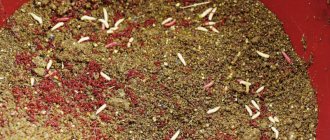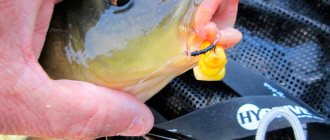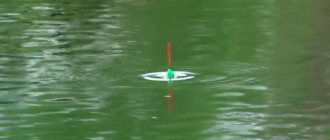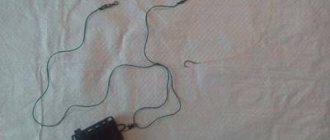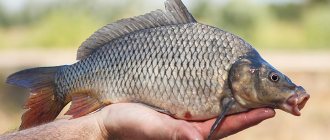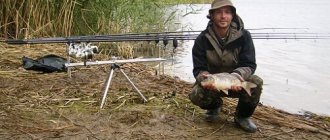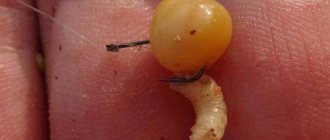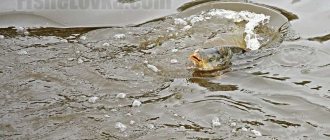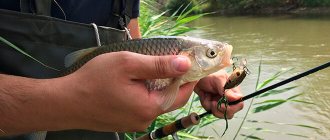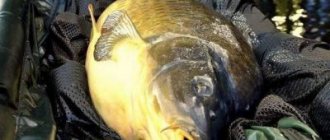Donka for carp is an old, proven method of fishing for the giant of our reservoirs. In the last 5–7 years, sport fishing for carp, or carp fishing, has been actively popularized, and serious financial investments are required to practice this sport. But budget fishing deserves no less attention, so catching carp on a donkey on a river or lake has become a favorite pastime for most anglers.
Why we are talking specifically about carp is understandable, because it is one of the most common inhabitants of our reservoirs. In addition, unlike crucian carp, adult carp reach large sizes, and catching a qualifying trophy is the dream of every angler.
Carps are found both in rivers and in closed reservoirs and perfectly adapt to natural conditions. The main thing is that there is a food supply, thanks to which young individuals grow quickly, gain weight and, as a result, are of great interest to fishing enthusiasts.
In this article we will talk about how bottom tackle for carp is tied, in what conditions it is best to use it and how to properly catch this strong fish.
Advantages of bottom tackle
Before moving on to how to catch carp on a bottom with a feeder, it is necessary to dwell on the positive aspects of this gear so that fishermen who are not yet familiar with the product can note all the advantages for themselves.
And these should include the following points:
- Thanks to the shock-absorbing properties of the reel, fishing is more convenient and faster.
- Fishing with gear is possible in almost every body of water, as well as at different depths.
- You can additionally lure fish to the fishing spot with tasty bait.
- The bait-equipment can be thrown over a long distance, up to 120 meters.
- The product can also be made with your own hands.
- The equipment can be equipped with a variety of alarms that will report a bite.
- Installation can be carried out in several ways, and this makes it possible to quickly adapt to a specific river and fish.
Summer fishing gear
To catch carp in the summer, fishermen have many options related to the choice of necessary gear. These can be ordinary float rods or bottom gear, including feeder ones.
Popular donks
You can fish with both traditional bottom gear, which fishermen have been using for many years, and modern, more advanced ones.
- Great master carp anglers use modern, more practical feeder gear. The feeder is a more reliable rod, which allows you to emerge victorious in a fight with this strong fish, especially a trophy one. Most carp anglers use electronic bite alarms, as it is very important to identify bites in a timely manner. A large specimen of carp is capable of “seizing” the gear from an unlucky fisherman.
- As a result of the use of conventional bottom gear, there are also losses, but the cost of manufacturing such gear is much less. The most interesting gear for bottom fishing may be:
- Spring;
- Pacifier;
- Makushatnik.
All of the above gear includes a rod, fishing line, reel, feeder and leash with hooks. They differ only in the design of the feeder, which affects the preparation of the type of bait: a more crumbly one is suitable for a spring, a more doughy one for a nipple. As for the top bait, this tackle is somewhat different in the technique of feeding bait. Here you can do without a feeder, since the bait is supplied to the fish in the form of a pressed piece of cake attached to the tackle.
When using such gear, it is unlikely that you will be able to see the moment of the bite. In such gear, the fish are caught on their own due to the weight of the feeder.
Float rods
There are fishermen who use classic float rods and can watch a motionless float for hours. Unfortunately, it is unlikely that you will be able to catch carp with a traditional float rod, especially a trophy one, since it requires some modernization.
- The match fishing rod is widely popular due to its effectiveness and affordability. Such a fishing rod can be equipped with a modern, lightweight, and at the same time, durable rod, strong fishing line, reliable reel and a sharp, powerful hook. Unfortunately, this is not enough and the quality of the equipment settings greatly affects the fishing efficiency.
- When fishing at distances of 10-15 meters, you can use more modern gear called a plug . Its basis is made up of separate knees, with which you can adjust the casting distance. Unfortunately, using the plug is not very convenient. Moreover, it requires a special stand. These are additional funds that not every fisherman has. This type of tackle does not have a reel and as much fishing line is tied to it as needed. When catching large fish, you need to use a rubber shock absorber to dampen the jerks of the fish, which will prevent the line from breaking.
How to assemble a bottom tackle with a feeder
The equipment consists of several important components. Among them the most important are:
- Rod. The ideal option in this case would be a feeder or a spinning fishing rod, 2-3.5 meters long. If possible, you should pay attention to the test, which ranges from 60-120 grams. If possible, it is advisable to use the most reliable fishing rod, which includes a two-arm plug product.
- Coil. The element must be inertialess. In order to easily fit 100 meters of fishing line onto a part, you need to take a 3-4 thousand spool. An additional advantage will be the baitrunner available on the reel.
- Fishing line. Of course, almost everything depends on the thread, so it should not be too thick, but at the same time it should have strength and reliability. It would be ideal to select an element where the diameter would be in the range of 0.2-0.35 mm. If a fisherman manages to find a thread with excellent breaking parameters, but with a smaller cross-section, then he can give preference to such a fishing line. Don't forget about the elasticity that only good monofilament has.
- Feeder. Considering that they go mainly to deep-sea reservoirs where there is no current to catch carp with bottom tackle, the feeder should be taken in a conical or cylindrical shape. A “cage” and a spring will also be suitable. The weight of the product should not exceed 80 grams.
Fishing on the top of the head
Catching carp on a fishing rod is quite an effective activity, although it is not considered a sport type of fishing. The main advantage of the makushatnik is considered to be the presence of bait (pieces of makushat) at the bottom of the reservoir for 3 hours; it does not become limp and attracts prey well.
Depending on the fishing conditions, the density of the top is chosen: harder bait is used for catching fish in the current, soft bait is used in reservoirs with standing water. To store makukha cubes, use a glass jar with a screw top.
It is unlikely that you will be able to purchase tackle on the market or in a specialized store; you will need to make it yourself from the following parts:
- A rigid rod with a length of 4 meters. Considering the weight of the top and the weight of the prey, the rod must have a sufficient margin of safety.
- Powerful spinning reel with 3000 - 4000 spool.
- The diameter of the selected fishing thread must fully correspond to the size of the catch. The optimal thickness of the fishing line is 0.25 – 0.45 mm, length from 150 m.
- Carp hooks with extended shank No. 6 – 8.
- Sinkers in the form of a dovetail and a horseshoe are for hunting in the current, and in reservoirs with standing water you can experiment with different shapes of products.
For catching small carp (up to 2 kg), conventional fly fishing rods with a length of 4–6 m, equipped with a spinning reel and monofilament, are suitable. Monofilament has sufficient elongation and absorbs strong jerks of carp well.
How to make donka
Bottom gear is easy to make. This topic will not be discussed in detail in the article, but below we will talk about what elements will be needed and how to choose them correctly.
The simplest do-it-yourself carp feeder has the following elements:
- Hook for carp. The shape and size of the part are selected based on the size of the carp that the angler plans to catch, as well as the type of bait. Often, according to the international classification, hooks numbers 6, 8, 10 are used.
- Bite alarm. You can choose what you like best: a quivertip, an electronic device or a bell. Using the last element, it must be removed when landing fish and casting a donkey.
Float rod
The use of float gear by carp anglers provides a number of advantages over classic donks, namely:
- Possibility to fish ponds and lakes where the bottom surface is covered with a thick layer of silt.
- to catch fish in hot weather when it is in the upper layers of the water.
- During the spawning period , carp stays close to the coastal zone; fishing with a float rod gives good results.
The choice of float gear is influenced not only by the size of the expected prey, but also by specific fishing conditions. The fly rod, plug and match are in great demand. To catch domestic carp weighing up to 2 kg, use any of the listed options, the main thing is that their breaking force matches the size of the carp.
A match fishing rod consisting of:
- A powerful long stick 3.5 - 4.0 m. Specialized stores offer a huge range of high-quality tools for carp fishing; special attention must be paid to the safety margin.
- A reliable spinning reel with a spool of 2500 - 3000 , taking into account the need to make precise casts over long distances.
- Monofilament fishing line with a length of 100 - 150 m , wound to the edges of the spool, so the process of unwinding it when casting will be simpler and easier. In some situations, a thicker fishing thread or cord is wound onto the bottom of the drum. The optimal diameter of the main line is 0.22 - 0.30 mm.
- Float. It is the float in the float tackle that is responsible for the flight range of the equipment. Modern versions of floats are equipped with a high and bright antenna and have a heavy body; their weight can be adjusted.
- Lead pellets, which act as weights, are placed between the hook and the float.
The rod should not be very long, but strong and durable. The most optimal rod length is 3.6-4.0 m. With this rod you can achieve the most accurate and long casts. The end should spring slightly, but at the same time be quite rigid. And, of course, to withstand the loads when playing fish. The reel is mounted as far from the rear end of the rod as possible. This arrangement of the reel allows you to use the tackle most conveniently when fishing for large fish.
How to catch carp on a donk
First you need to decide on a place. It is advisable that this be an area where there are no dense thickets. Next, you need to prepare gear for carp fishing, as well as bait.
Important! Water from the reservoir in which the fisherman will fish is added to the bait.
Having dealt with this, you can move on to feeding the point itself. For this purpose, you can take a bait cobra or slingshot. There are anglers who have enough feeders, but in this case you need to be prepared for the fact that you will have to make more than a dozen casts, and this is not always convenient. In addition, sometimes such behavior causes the fish to disperse in different directions, not understanding what is happening. In any case, everyone must decide for themselves what they will use.
Having finished with the bait, you can start throwing gear into the pond. It is important to pay attention to the tension of the fishing line, which will directly affect the sensitivity of the donkey to carp.
The mistake of many novice fishermen is that, having laid everything out, they completely forget to put a landing net or a bucket nearby, and then, starting to fuss, they get lost, throwing away both the equipment and everything else. Preparation is an important stage of fishing, so it should not be neglected.
Many people also have a problem with re-casting the donkey. There are fishermen who claim that equipment and baits should be checked every 20 minutes. Others argue until their voices become hoarse that frequent casting will frighten the carp, which then will not swim up to the fishing spot at all. Therefore, it is advisable not to touch the rod for an hour and a half.
What to do is a personal matter for each fisherman. However, many people settle on the “golden mean”, viewing the equipment no more than once every 40 minutes.
How and which spinning rod to choose?
Spinning rod for carp fishing should be light , but it is better not to take ultralight: fishing with ultralight tackle is extreme, but ineffective, because the carp is strong and rather large. We choose a fishing rod that is powerful enough and resistant to sudden loads (Norstream tackle: Provokator, Norstream Stage, ULTIMA, Micromania, Ultrasence, Stage, Areal, etc.).
For carp fishing, a spinning rod with a medium action is recommended. You won’t be able to cast the bait very far with such a rod, but the fish rarely leave it.
Carp anglers also praise the heavy Crocodile spinning rod with a length of 2.4 meters and a weight of 250 grams. There are Crocodile rods with other lengths, for example, 2.7 meters.
If the temperature outside is sub-zero, which often happens in the fall, ice forms on the spinning rings. To prevent this from happening, you need to stock up on special lubricant.
Telescopic spinning rod
A telescopic spinning rod is compact - this is perhaps its only advantage over a plug-in spinning rod.
There are no composite telescopic rods yet that are suitable for ultralight lures. Therefore, for carp hunting it is better to purchase a carbon fiber spinning rod . It is more expensive, but more sensitive and durable.
Telespinning rods Mini Spin Tele (Daiwa), EXAGE BX STC MINI (Shimano), Fantom, CATANA CX are universal and suitable for carp fishing.
Donka with a feeder - what you need to know about the equipment
When using bottom tackle for carp along with a feeder, then special attention is paid to the installation of the structure. Not everyone takes into account the fact that carp is one of the strongest and most sinuous fish, so the slightest missed nuance will cost the catch.
Therefore, it is important to pay attention to the following points:
- When installing, you should use a sliding weight, which usually replaces the feeder. This is necessary so that the fish does not feel resistance when biting. Otherwise, the carp may throw the treat along with the hook. Mounting a sliding sinker is simple: you need to place two stoppers at a distance of 10 to 20 cm, which will limit the movement of the load.
- Some resort to installation like an asymmetrical and symmetrical loop. Sometimes the equipment involves replacing leashes. The reason is the impossibility of predicting the behavior of fish in a reservoir. If the bite does not occur, it is necessary to replace the element with a thin one (the diameter of the line should be from 0.1 to 0.14 mm), as well as a long one (from 0.6 to 1.2 meters). It also doesn't hurt to use a smaller hook. Therefore, experienced people advise installing such replaceable gear in advance so as not to waste fishing time on it.
- In addition, if you are fishing for large carp weighing about 4 kg, then you will need to give preference to an asymmetrical loop, “method” or inline. These are all self-cutting tackles. If large trophies are not caught on the river or small fish are enough for the fisherman, then it is better to pay attention to paternostera. The element transmits even the most imperceptible bites, so you won’t miss the fish with it.
Correct rigging
- The fishing line plays an important role . It seems to be good to make fluorocarbon (fluorocarbon). But this is not the most durable option, in addition, the fly is hard, scares the carp, and it spits out the bait. Opinions are divided on the best line for carp fishing. Someone claims that carp are perfectly caught using 0.13 mm braid: it is invisible, durable and does not scare the fish. Other fishermen note the insufficient ability of the braided cord to stretch (the jerks of the fish are not dampened, the lip is often damaged) and advise equipping the spinning rod with monofilament.
- a reel with a rear clutch, a spinning one. Imported Shimano and Daiwa (TS-COOOT, 2500 XiA) are especially popular among fishermen for carp fishing. Shimano has reels specifically designed for carp fishing. They have a wide spool that allows you to make long casts even with a thick line and 2 controlled brakes. If the line gets too tight and is about to break, the reel automatically unwinds a couple of turns.
- If you decide to use a leash , try the Multi-Strand. It consists of fibers invisible in water. You can also use Technipeche, Star Baits or Kryston leashes. Good leashes made by Partridge.
Hooks should be checked for sharpness after a bite: carp fishing quickly dulls hooks.
How to fish with bottom tackle correctly
Experienced fishermen use bottom tackle without any problems and go with it for carp in winter and summer. It's another matter for beginners. Many of them do not know that fishing with the presented tackle depends on the time of year, the depth of the reservoir, the passivity or activity of the fish, the chosen bait and much more. All these little things add up to good or bad fishing.
Therefore, you need to know some important nuances that will make it possible to return home with a trophy fish, and not empty-handed:
- As a bait, you don’t need to choose mastyrka, dough, bread and the like, since all these products do not stick well to the hook and sometimes fly off during casting. It is better to give preference to maggots, worms, boilies, peas, corn, larvae, insects, etc. You need to remember that the filling must be more appetizing than the bait so that the carp pecks it more actively. Therefore, it is better to choose dusty boilies as bait, which cannot be fully enjoyed. It is recommended to add flavorings to the bait, which would awaken a stronger appetite in the fish.
- At different times of the year it is necessary to select different delicacies. So, in autumn and spring, it is recommended to add as many nutritional components containing proteins as possible to the bait that will be poured into the feeder. During this same period, you cannot do without flavorings such as anise, mint, garlic, cake, sunflower seeds and the like. In the summer, you can choose less nutritious treats, but they must smell like “summer”, so you need to give preference to flavors with the smell of cinnamon, vanilla, berries, fruit cookies, cocoa, honey and the like (read about different types of cake and its preparation in a separate section article).
- The accuracy of an angler is something that plays an important role in fishing. During casting, a person must send the feeder as accurately as possible to the point that was chosen in advance. Therefore, it is better to practice with this activity the day before so as not to make re-rolls until the goal is finally achieved.
- When feeding bait, there is no need to try to feed the entire stock. You should choose a small area and work with it. If nothing works out, then you can move on.
Important! If the fish are not biting in any area, most likely the reason is bad weather or low pressure.
In this case, it is better to leave this matter for a while and then return to it again. Fishing for carp requires some patience and effort, but the results are worth it.
Hair rig for carp fishing
This is the most popular and safe carp installation. When using it, the hook remains free. When the boilie ends up in the carp’s mouth, the hook automatically goes there too. The hook should always be pointing downwards. Hooking occurs at the moment when the fish tries to spit out the hook with the nozzle and tries to leave the place.
Hair fishing is used in sport and amateur carp fishing. It is subject to increased requirements for strength. To make the equipment, you need a braided or fluorocarbon leash with a diameter of 0.3 mm, a hook No. 6, a silicone tube, special glue, a needle for attaching boilies, and a rubber anti-twist. The hook is used in the shape of a banana. It detects carp well and holds it securely when fishing.
Cut off 20 cm of the leash material and knit a loop at the end. Next, cut off 2 mm of the silicone tube and put it on the leash. Then we take the hook and insert it into the tube so that the tube is opposite the sting. Next, we put the boilie on the needle and, using the needle lock, fix the loop of the leash and pull the boilie onto the hair. And at the end we fix the boilie with a stopper threaded through a loop. As a result, we should have a montage like this:
If the bait needs to be raised slightly above the bottom, then a foam ball is attached to the hair rig. In this case, the hook and boilie will be located at a distance of 3-5 cm from the bottom. You can also use floating boilies. In this case, foam plastic is not needed. They are made like airy dough.
Tips for fisherman: What is the best fishing line thickness for carp - Let’s break it down step by step
All equipment looks like this:
You can buy ready-made installations in a store or buy individual elements and make them yourself. If you want to make them yourself, buy the ones that are most suitable as samples and make similar installations yourself.
The test is assigned to each rod after passing the load test. When the rod tip bends to 90 degrees, the weight required for this is the test of the rod. This number lets us understand how strong the rod is and how much weight it can withstand at maximum loads. The smaller the test, the softer the rod, but at the same time the casting range and the possibility of landing large fish decrease. The higher the test, the stiffer and longer-range the rod.
